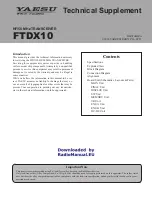
page 18
MARK-V FT-1000MP Operating Manual
N
OTE
: C
OMPUTER
-G
ENERATED
RFI
When using a TNC connected to your transceiver,
or even having a PC located in the shack, the possibil-
ity exists that you may experience computer-generated
RFI (Radio Frequency Interference).
The CPU in a personal computer operates with a
crystal-controlled oscillator (clock) and timing circuits.
Common clock frequencies include 8, 12, 16, 20 and
25 MHz. In addition, high-speed digital data switching
uses square waves, which produce odd-order harmonic
frequencies.
Computer-generated RFI may appear at seemingly
random frequencies (usually right where a rare DX sta-
tion is calling CQ!) throughout the range of your trans-
ceiver, and may sound like constant ticking or buzzing
that may change as you type or work within a program.
Severe RFI may have S-meter indications as much
greater than S-9, making copy of voice signals difficult
and data signals virtually impossible.
Computer-generated RFI is usually a result of in-
adequate shielding of the PC’s cabinet or I/O and pe-
ripheral connections. While computer equipment may
comply with RF emission approval standards, this does
not ensure that sensitive amateur radio receivers will
not experience RFI from the device.
There are a few steps you can take to reduce or
eliminate computer-generated RFI. The first step is to
ensure that only shielded cables are used for TNC-to-
transceiver connections, carefully check RF ground
connections and re-orient your station equipment in
relation to the computer. Try moving your PC and pe-
ripherals slightly and see if it has any affect on the RFI,
in some cases, this alone may be enough to correct
the problem.
If not, several additional steps to try include install-
ing AC line filters on the power cord(s) of the suspected
equipment and inserting decoupling ferrite toroidal
chokes on interconnecting patch/data cables and
smaller ferrite beads on single wires.
As a last resort, you can try installing additional
shielding within the PC case, using appropriate con-
ductive mesh/screening or conductive tape. Especially
check RF “holes” where plastic is used for cabinet front
panels. For further information, consult amateur radio
reference guides and publications relating to RFI sup-
pression techniques.
A
CCESSORY
I
NSTALLATION
D
IGITAL
M
ODEM
(TNC, W
EATHER
F
AX
,
ETC
.) I
NTERFACING
















































